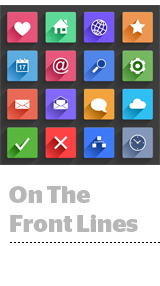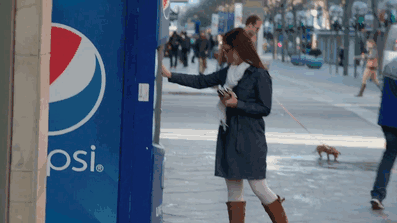 Brands are on the constant hunt for engaged audiences.
Brands are on the constant hunt for engaged audiences.
It’s why they attend upfronts for television, NewFronts for digital, future fronts for programmatic, podcast upfronts for audio – and, now, AppFronts for apps.
General Electric hosted its first AppFronts on Tuesday in New York City, gathering together an audience of brands and agencies for an event that was one part demo day, one part networking opportunity and one part ad sales pitch.
Twelve up-and-coming apps – Medium, BarkBox, Flirtey, Genius, Giphy, Mic, Poncho, Robinhood, Slack, Shots, Timehop and Wattpad – took the stage to extol their virtues and explain why they’re deserving of budget.
And there’s a lot of potential budget on the table. The crowd included representatives from Unilever, Chobani, L’Oréal, The Home Depot, Mattel, Southwest Airlines, Johnson & Johnson, Pepsi and other blue-chip brands.
All are ostensibly looking to reach millennial audiences through mobile.
“It’s a watershed moment,” said Linda Boff, executive director of global brand marketing at GE. “The amount of time people are spending in apps has surpassed the amount of time they spend watching television.”
In 2015, US consumers spent 168 minutes per day watching TV, in contrast to the 198 minutes they spent in mobile apps, according to recent data from Flurry.
There might be some skepticism about adding another “front” to an already crowded lineup of front-related events, but the turnout at GE’s AppFront was evidence that brands are hungry for new native opportunities, said Sam Olstein, global director of innovation at GE.
“Traditionally, upfronts are all about tapping into scalable audiences,” Olstein said. “And that’s just what apps do. They bring very substantial – and scalable – audiences.”
One such app is Wattpad, which describes itself as a social network for serialized stories, articles, poems and fan fiction. It boasts a community of 40 million monthly active users, 80% of whom are under 30.
AdExchanger Daily
Get our editors’ roundup delivered to your inbox every weekday.
Daily Roundup
The average user spends about 30 minutes in the app per session. And that’s “in an age of inattention,” said Candice Faktor, Wattpad’s head of business.
Wattpad has already done work with a number of high-profile brands, including creating a series of branded “sour and then sweet” love stories for Sour Patch Kids to coincide with Valentine’s Day, a sponsored list of “timeless love stories” to promote the Lionsgate release of “The Age of Adaline” and a student essay contest sponsored by Chipotle.
It’s about “promoting stories in an authentic and native way,” Faktor said.
GIF search engine Giphy is a good example of that. Giphy has 55 million users across web and mobile, with 68% of its traffic coming from users aged 18 to 34.
Giphy curates a fully functional GIF ecosystem complete with tools to help brands and individual users create, distribute and share GIFs. One tool allows brands and publishers – Giphy works with the likes of Pepsi, Citi, The History Channel, The Huffington Post, USA Today, The Atlantic and AOL – to convert videos into GIFS by automatically identifying the most GIF-worthy stills within.
“The beauty of the animated GIF is that it gets the idea of something emotional and effective across to the user in a matter of seconds,” said Simon Gibson, director of marketing and acquisitions at Giphy. “It’s the perfect middle ground between a static image and a video.”
GIFs autoplay, don’t eat away at data plans or battery life and, according to Giphy, are three times to five times more engaging than images or video.
 And that speaks to a deeper issue, one that sits at the heart of an existential crisis that’s making advertisers and publishers rightly nervous: the growing trend toward blocking ads in reaction to third-party tracking, slow load times, data drainage and disruptive and irrelevant ad experiences.
And that speaks to a deeper issue, one that sits at the heart of an existential crisis that’s making advertisers and publishers rightly nervous: the growing trend toward blocking ads in reaction to third-party tracking, slow load times, data drainage and disruptive and irrelevant ad experiences.
But immersive apps, like the ones on display at the AppFront, could provide a reset button for the industry.
“What ad blocking will mean for everyone in the ad industry is that they need to start thinking differently about the mobile experience,” Tom Goodwin, SVP of strategy at Havas, noted in a recent Ad Age column. “Ad agencies need to get imaginative, publishers and media owners need to start respecting consumers’ attention spans and brands need to produce quality messaging and learn to attract and entertain.”
The opportunities are there. A brand could sponsor an artist release through music lyric app Genius (40-plus million monthly uniques, 60% mobile traffic), distribute native content through blogging platform Medium (reach of 28 million readers, 400,000 articles posted per month) or create branded products through Bark & Co. (reach of 45 million dog owners), the canine-themed product, tech and ecommerce company behind BarkBox.
It’s just a matter of being creative – without being derivative.
“As much as these are channels for distribution, you have to put the medium and the message together,” Olstein said. “You can’t just repurpose your TV or digital assets 20 different ways for each of these apps.”
And that means allocating media spend.
Beyond acting as a showcase for a bunch of cool apps and a facilitator of creative idea sharing between the app makers and advertisers, the AppFronts is also meant to be a place where deals are made. That’s where the “front” in “AppFront” comes in, said Nick Adler, VP of business development at Cashmere Agency, which helped organize the event. Cashmere plans to run the AppFronts several times each year in multiple markets.
“We definitely envision people budgeting and having specific objectives and buys coming out of the AppFronts,” Adler said. “We do want people to walk into that room with specific budget to spend and to execute on that budget, if not at the event, then quickly thereafter.”
The apps, however, walk a fine line between the need to make money and the need not to annoy their users.
“These apps don’t even really want to sell advertising – this is about looking for a revenue model,” Adler said. “It’s about turning on a model that doesn’t scare consumers so that they jump to another platform, because this is a very fickle audience.”
But it’s a fickleness that can give way to fierce loyalty if users are given a reason to care, Adler noted.
Which is a big part of what makes apps so appealing as a media channel. By downloading an app, users raise their hand to say they’re interested in whatever that app has to offer. It’s a self-selected audience, and when advertisers buy it there’s arguably less waste than when they “bullhorn” their message on television, Olstein said. “The world of apps is just incredibly precise.”
But it’s also vast, said Beth Comstock, vice chair of business innovations at GE. That makes it difficult to decide which apps to focus on.
“There are few technologies as nimble and efficient at delivering information than an app – they have the ability to create audience and engagement seemingly overnight,” Comstock said. “[But] the choices are really overwhelming.”
Hence, the AppFronts are born.













